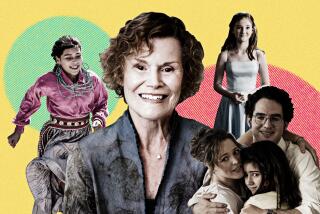Exploring Sexual Legends Can Help Teens Get Beyond the Myths
- Share via
Like urban myths, the contemporary sexual legends that are passed off as truth by adolescents often center on graphic and bizarre facts.
Usually, the legends focus on libidinous behavior that, once discovered, humiliates the “oversexed” protagonist--the girl who gets pregnant in a hot tub without having sex, for instance, or the teen whose one-night stand leads to a deadly surprise.
A collection of sexual legends promulgated by adolescents is explored and interpreted in a book published last year. “Did You Hear About the Girl Who ... ? Contemporary Legends, Folklore, & Human Sexuality” was written by Mariamne H. Whatley and Elissa R. Henken.
Whatley, a biologist and professor of women’s studies at the University of Wisconsin at Madison, and Henken, a folklorist and professor in the English department at the University of Georgia at Athens, claim that much of what teenagers believe about their bodies and human sexuality is learned informally on the playground, in school halls and from the lore shared among classmates.
Rather than ignoring the legends as teen piffle, the pair, who are sisters, argue that health educators, clinicians and anyone who works with adolescents should make use of sexual lore to speak to teenagers in their own language. The legends are windows on the world of adolescents, openings to a discourse about what they believe, question or have heard about sexuality.
In a piece for “Women’s Review of Books,” a monthly publication out of Wellesley College, psychologist and sex expert Leonore Tiefer applauds the book. The authors, she writes, “propose a wonderful interdisciplinary idea ... using sexual urban legends as part of high school and college sex education ... a corrective to the often ineffectual attempts of sex educators to stamp out sexual myths with earnest recitations of facts ... [they] view classroom discussion of urban sex legends as one way of dealing with students’ persistently irrational beliefs. In their eyes, irrationality must be explored, not dismissed.”
Sexual legends, like a well-narrated story, are more compelling, salient and widespread than the dry information in sex education textbooks, write Whatley and Henken. The stories resonate deeply with adolescents who are trying to figure out the mechanics of sex and what is acceptable--information they are more likely to accept as fact from friends than from teachers.
“Teaching by facts is not good pedagogical technique,” said Whatley. “Facts also can coexist with misinformation. Students can learn about physiology and how reproduction works, but they may still firmly believe that they won’t get pregnant if they have sex standing up.”
Sexual legends often spring from the anxieties or desires of adolescents. Consider the widespread story of “the promiscuous cheerleader” who performs a sex act on each player of the basketball team. She collapses and has to be rushed to an emergency room, where her stomach is pumped, providing proof of her indiscretion.
This legend often circulates among boys in middle school, for whom cheerleaders may be unattainable, but highly desirable sexual objects, according to an analysis by Northwestern University sociologist Gary Alan Fine in his 1992 book, “Manufacturing Tales: Sex and Money in Contemporary Legends.”
” ... Since semen is largely protein,” he writes, “there is no medical rationale for pumping the girl’s stomach. The stomach pumping serves as punishment.”
In a telephone interview, Fine summed up the legend’s message: “The girl getting her stomach pumped puts the world in balance because a sexually aggressive woman cannot be tolerated.”
Whatley and Henken propose that health educators and others who work with adolescents elicit legends from students by asking, “What have you heard about ...?” or by placing a “things you’ve heard box” in the classroom. In critically examining a legend, an adolescent should be asked to consider whether it is medically or physically possible (such as the tale of the sperm that made its way to the girl in hot tub, impregnating her).
The authors also urge educators and parents to help adolescents understand the underlying moral and social messages inherent in sexual legends.
Teenagers should also be asked to discuss whether legends have positive or negative messages. A legend about a gay roommate drugging his heterosexual roommate to have sex with him reinforces homophobic beliefs that gay men are predatory. A legend about how having sex while standing cannot result in pregnancy could, indeed, lead a misinformed teen to unwanted pregnancy.
Last, the authors suggest that students be asked to determine why a particular legend exists, how it maintains what is acceptable in a group and what cultural attitudes foster it. All of this helps adolescents understand and dispel the legends, while learning the basics about human sexuality.
“One of the things that legends do is take beliefs that can’t be expressed directly, such as stereotypes, homophobic and racist beliefs,” said Fine. “When you are talking about things that have ostensibly happened to you or someone you know, you have license to state these beliefs, even if it is by repeating rumor or legend.”
What makes some sexual legends compelling is that they often contain a grain of truth. “Many legends contain the possibility of being true. Even if some part of it is wrong, other parts may be true,” said Henken.
Take the widespread legend about a girl on spring break in Florida who meets a guy and falls in love. The final night of vacation, she sleeps with him. He gives her a tiny box as she leaves, telling her not to open it until she arrives at school. Upon opening it, she finds a miniature coffin inside inscribed: “Welcome to the wonderful world of AIDS.” (Male version: A man spends the night with a woman he picks up in a bar. The next morning he finds scrawled on the mirror in lipstick: “Welcome to the wonderful world of AIDS. ... “)
“It is true that unprotected intercourse can result in the transmission of AIDS,” said Whatley. “And it is true that a person could fall in love with someone who has AIDS.”
The authors collected hundreds of sexual legends. The legends heard in the U.S. were similar to those heard in Australia and England.
Statistics suggest that American sex educators could do a better job, compared with their international counterparts. U.S. teenagers have the highest pregnancy rate compared with Germany, France, England and Holland and 25 times the rate of HIV infection, according to a 1999 Kaiser Family Foundation study.
Though a wave of abstinence-only sex education is spreading across the country (23% of public school districts teach abstinence-only sex education), Whatley and Henken are optimistic that there is room for discussion of graphic, sexual legends and that such discussion would help educators, health workers and parents address specific misconceptions adolescents hold about sexuality.
“If students themselves are raising the questions, there is more flexibility for discussion even in school districts that teach abstinence-only curriculum,” said Whatley. “Creative teachers could do a lot with contemporary sexual legends.”
*
Birds & Bees, a column about sexuality and relationships, runs on Monday. E-mail: kathykelleher@adelphia.net.
More to Read
Sign up for our Book Club newsletter
Get the latest news, events and more from the Los Angeles Times Book Club, and help us get L.A. reading and talking.
You may occasionally receive promotional content from the Los Angeles Times.









